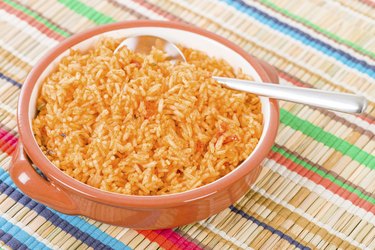
Spanish rice, sometimes called Mexican rice, is a dish made with long grain white rice, onions, green peppers and a form of tomatoes, such as tomato sauce, tomato paste or canned tomatoes. Some recipes call for garlic and celery; saffron, chili powder or cumin is often added as seasoning. The vegetables and rice create a low-fat, low-calorie dish that delivers vitamins and minerals.
Definition
Video of the Day
Nutritional values are based on a serving size of 1 cup of rice and 28 g each of onions, green peppers and tomato sauce. The amount of nutrients you receive may differ depending on your portion size.
Video of the Day
Vitamins
Green peppers and tomato sauce are good sources of vitamin C and together with the onion, one serving of Spanish rice provides 26.7 mg of vitamin C. You'll gain 249 IUs of vitamin A from the combined green peppers and tomato sauce. All of the ingredients contribute B vitamins, but rice alone delivers 0.26 mg of thiamin, 2.33 mg of niacin and 5 mcg of folate.
Minerals
While one serving of Spanish rice provides all the essential dietary minerals, the ones found in greatest quantity are calcium, iron and potassium. The dish delivers 28.5 mg of calcium and 239.3 mg of potassium. The total iron is 2.29 mg, with rice contributing a little more than 70 percent.
Fat, Fiber and Calories
Spanish rice is a healthy low-fat dish. The vegetables contribute no fat, and 1 cup of long grain white rice has just 0.4 g of total fat and no cholesterol. You'll also gain about 1.4 g of dietary fiber and 231 calories.
Choline
Important for cell structure, communication between nerves and the transportation of fats through the body, choline must be obtained through the diet. One serving of Spanish rice delivers about 9.7 mg of choline.
Glycemic Value
If you need to watch your blood sugar, you may be concerned about carbohydrates that cause blood sugar to rapidly rise. The glycemic index rates foods according to how quickly they raise blood sugar. Foods rated at 55 or less are considered to be low glycemic, meaning that they do not cause an unhealthy spike in blood sugar, according to the American Diabetes Association. Long grain white rice may be rated anywhere from 39 to 109, depending on the brand, but most are in the 50 to 60 range, according to The Glycemic Index.